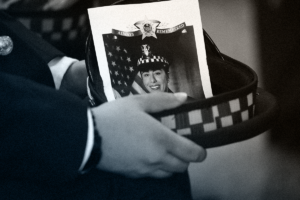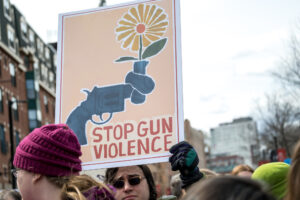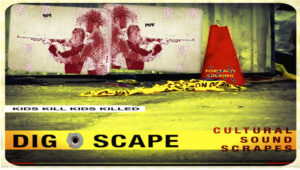Violence Is Deeply Rooted in American Culture
The gun violence figures flooding the media in the wake of the Newtown massacre are startling, "but they do not tell us enough about the cult and spectacle of violence in American society. Nor do they make visible the myriad of forces that has produced a country drenched in bloodshed and violence," Henry Giroux told C.J. Polychroniou in a Truthout interview.
This piece originally appeared at Truthout.C.J. Polychroniou:
America’s fascination with guns is turning into an ever growing nightmare, with the latest carnage taking place last month at Sandy Hill Elementary School in Newtown Connecticut where 20 young children and six educators were killed. Yet, there is no evidence that the US is any closer to joining the rest of the civilized nations and imposing strict gun control laws in order to reduce violent crime. Is the National Rifle Association largely to blame for this?
Henry A. Giroux: After every national tragedy involving guns, the American public is being inundated with figures about gun violence, ranging from the fact that more than 84 people are killed daily with guns, to the shocking statistic that there are more than 31,000 gun-related deaths annually. In 2010, for example, there were 8,775 murders by firearms in the U.S., while in Britain there were only 638. Moreover, there are 300 million firearms in a country of just over 311 million and just over 47 percent of Americans own guns. Most disturbingly, as pointed out by the Children’s Defense fund, is the fact that in 2010, “2694 children and teens were killed by gunfire [and] since 1979 …a shocking 119,079 children and teens have been killed by gun violence. That is more child and youth deaths in America than American battle deaths in World War I (53,402) or in Vietnam (47,434) or in the Korean War (33,739) or in the Iraq War (3,517).”[1] These are startling figures, but they do not tell us enough about the cult and spectacle of violence in American society. Nor do they make visible the myriad of forces that has produced a country drenched in bloodshed and violence.
There is little doubt that the role of the NRA is instrumental in the violence haunting American culture, or that gun control is important, but it is only one factor in the culture of symbolic and institutional violence that has such a powerful grip on the everyday cultural apparatuses and workings of American society. The issue of violence in America goes far beyond the issue of gun control. When gun control is the focus — instead of a broader consideration of violence — it can actually serve to deflect the most important questions that need to be raised. The grave reality is that violence saturates almost every aspect of North American culture. Domestically, violence weaves through the cultural and social landscape like a highly charged forest fire burning everything in its path. Popular culture, extending from Hollywood films and sports thuggery, to video games, embraces the spectacle of violence as the primary medium of entertainment. The real issue here is the existence of a pedagogy of violence that actually makes the power of deadly violence attractive. Representations of violence dominate the media and often parade before viewers less as an object of critique than as a for-profit spectacle, just as the language of violence and punishment now shapes the U.S. culture — with various registers of violence now informing school zero-tolerance policies, a bulging prison-industrial complex, and the growing militarization of everyday life. There is also the fact that as neoliberalism and its culture of cruelty weaves its way through the culture it makes the work place, schools, and other public spheres sites of rage, anger, humiliation, and misery, creating the foundation for blind rebellion against what might be termed intolerable conditions. Accepting the logic of radical individual responsibility, too many Americans blame themselves for being unemployed, homeless, and isolated and end up perceiving their misery as an individual failing and hence are vulnerable to forms of existential depression and collective rage. We have seen such violence among students reacting to bullying and among postal workers responding to intolerable work conditions. There is no one cause of violence, but a series of a number of causes that range from the war on drugs and the militarization of police departments to mass incarcerations in prisons to the return from brutal wars of many trained killers suffering with PTSD.[2] All of these factors combine in an explosive mix to create an dangerous culture of violence and cruelty and as Jeff Sparrow points out a “willingness of ordinary people to commit unthinkable atrocities.”[3]
C.J. Polychroniou: Is this what you mean when you refer in your writings to a break down between the realm of war and civil life?
Henry A. Giroux: Exactly. The metaphysics of war and associated violence creep into everyday life in the United States, a process which has intensified since 9/11. War and militarism not only eat up resources and revenue, it also determines the more general meanings that shape the values of social relations of everyday life and is constitutive of both social power and culture itself. Under neoliberalism, markets are now fused with the warlike logic of militarization as ways of thinking, subject positions, and the ordering of social relations are fused, as the philosopher David Theo Goldberg points out, with “military truth, structure, and temporality.”[4]
Of course, what I mean by this is that is the United States is not only obsessed with military values shaping foreign policy, but war and militarism have become a mediating force that now seep into almost every aspect of daily life. War now makes men, and becomes the most important logic mediating not simply contemporary views of masculinity but social relations in general. We see war and its dynamics of cruelty and punishment seeping into a whole range of institutions. For instance, we see schools and social services modeled increasingly after prisons. We see police forces being paramilitarized. We see popular culture endlessly celebrating the spectacle of violence. What is startling is that the logic of war and violence have become addictive, a socially constructed need that we simply cannot get away from. Violence has become a defining organizing principle of society that has become one of the few shared mediating forces that now holds everyday life together. What is crucial to acknowledge here is that “the fields of politics and violence—a violence that seems to lack rational organization, not excepting self-destruction—are no longer separated. They have progressively permeated one another.”[5]State violence is now amplified in the rise of the punishing state which works to support corporate interests and suppress all forms of dissent aimed at making corporate power accountable. Violence as a mode of discipline is now enacted in spheres that have traditionally been created to counter the symbolic and institutional violence perpetuated by forms of state and corporate sovereignty. Airports, schools, public services, and a host of other public spheres are now defined through a militarized language of discipline, regulation, control, and order. Human behavior is now reduced to the instrumental logic of cost-benefit analyses, market shares, and profit ratings. Human relations and behaviors are not simply militarized, viewed as targets, but also reified and dehumanized making it easier to legitimate a culture of cruelty and politics of disposability that are central organizing principles of casino capitalism.
C.J. Polychroniou: Where does all this come from?
Henry A. Giroux: Part of it comes from the fact that all of a sudden we live in a society marked by what some have called “a failed sociality.” We have no language for democracy. We have no language for compassion. Neoliberalism collapses public issues into private troubles and in doing so not only destroys democratic values and forms of solidarity, but also extends a continuity of cruelty, misery, and exploitation into every sphere of everyday life–from schools and the work place to the workings of a state that now thrives on punishing rather than nourishing the welfare state. We view any form of dependency, any form of regard for the other as humiliating and worthy of scorn. We live in a neoliberal market-driven culture that basically celebrates an unchecked notion of self-interest and narcissism. This is a culture that has gone over the top in its worship of celebrity culture and violence. It views the news as a video game, a source of entertainment where a story gains prominence by virtue of the notion that if it bleeds it leads. So it’s really not surprising in the lack of any substantive existence of a formative culture that would value a sense of compassion and regard for the other that we end up in a moral vacuum in which violence finds suitable legitimation. And of course, formal education has been turned into a quest for private satisfactions and is no longer viewed as a public good, thus cutting itself off from teaching students about public values, the public good and engaged notions of critical citizenship.
What has emerged in the United States is a civil and political order structured around the criminalization of social problems and everyday life. This governing-through-crime model produces a highly authoritarian and mechanistic approach to addressing social problems that often focuses on the poor and minorities, promotes highly repressive policies, and places undue emphasis on personal security, rather than considering the larger complex of social and structural forces that fuels violence in the first place.
C.J. Polychroniou: In your writings, you also talk of the “neoliberal terror” and the politics of disposability that has taken hold over American society, suggesting that there is a new form of class warfare directed against the poor and the working class. Would you elaborate a bit on this?
Henry A. Giroux: In the US there is an institutionalized regime of neoliberal violence directed against low income people, poor minorities, immigrants, the disabled, and others now considered disposable under a ruthless and savage fanatical capitalism that luxuriates in the poisonous dream worlds of commodification, deregulation, consumption, and privatization. Within this regime of neoliberal violence, the politics of disposability is shored up by the assumption that some lives and social relationships are not worthy of a meaningful social existence, empathy and social protections. For instance, those considered “other” because of their lack of capital, consuming power, or alleged refusal to accept the unethical grammar of an Atlas Shrugged winner-take-all ethos are now relegated to zones of abandonment and terminal exclusion. Lacking social protections, such populations increasingly are addressed within the growing reach of the punishing state, as a source of entertainment, or are relegated to what the French philosopher Etienne Balibar calls the “death zones of humanity.”[6]
In a culture defined by excessive inequality, suffering, and cruelty, the protective covering of the state, along with the public values and the formative culture necessary for a democracy is corrupted, increasingly dismantled, and held in contempt. And the disposable are not merely those populations caught in extreme poverty. Increasingly, they are individuals and groups now ravaged by bad mortgages, poor credit and huge debt. They are the growing army of the unemployed forced to abandon their houses, credit cards and ability to consume — a liability that pushes them to the margins of a market society. These are the groups whose homes will not be covered by insurance, who have no place to live, no resources to fall back on, no way to imagine that the problems they will be facing are not just personal, but deeply structural, built into a system that views the social contract and the welfare state as a lethal disease.
In this economic Darwinist measure of value, those marginalized by race and class, who might detract from, rather than enlarge another’s wealth are not only demonized, but are also viewed as problematic in that they become burdens to be disposed of, rather than a valuable and treasured human resource in which to invest. The discourse of disposability is not limited to right-wing politicians, but it is also built into the vocabulary of neoliberal governmental policy. Market societies are ruled by a predatory form of economic Darwinism in which greed and avarice are legitimated through a war-against-all, survival-of-the-fittest mentality that embraces a near sociopathic lack of interest in others and provides few social protections against individual and collective misfortune while at the same time dismissing the value of social provisions. As the sociologist Elliott Currie has pointed out, neoliberal societies have become criminogenic in that they destroy peoples’ livelihoods, withdraw public supports, create massive extremes of economic inequality, erode social bonds while creating debilitating forms of atomization, promote materialistic values that produce a culture of callousness, corrupt the political process, and market a form of normalized brutality evident in the massive rise of corporate crime and a culture of corruption.[7] Neoliberalism represents a full-fledged assault on democratic values, relations, and public spheres and does so by universalizing its own ideology, policies, and modes of governance. Its logic of disposability reduces citizenship to the logic of consumerism, reinforces the dominance of public life by giant corporations, and produces what the anthropologist Joao Biel calls a “machinery of social death.” In fact, the “machinery of social death,” is fed by corporate investments in the organized production of violence for profit and I am not just talking about industries that make big profits as part of the military-industrial complex. As New York Times journalist Andrew Ross Sorkin states, what has been overlooked in the recent debate about gun worship in the United States is that some of the biggest gun makers are “owned by private equity funds run by Wall Street titan.” For instance, Cerberus Capital Management, Sciens Capital Management, and MidOcean Partners make big profits selling everything from Ak-47s to military-grade night-vision goggles.[8] The technology of death is a big profit maker for Wall Street and makes clear that neoliberalism is actively engaged in the production of a dystopian society in which people, resources, and goods are now considered throwaways, just as moral responsibility is detached from actions, and politics is removed from the promise of a substantive democracy.
Notes:
[1] Marian Wright Edelman, “Dear God! When Will It Stop?”, Common Dreams, (December 15, 2012). Online: https://www.commondreams.org/view/2012/12/15-0
[2] Don Hazen, “We are a country drenched in Bloodshed: Some Hard thoughts About Violence in the Media,” Alternet (December 20, 2013). Online:http://www.alternet.org/media/we-are-country-drenched-bloodshed-some-hard-truths-about-violence-media
[3] Jeff Sparrow, “When the Burning Moment Breaks: Gun Control and Rage Massacres,” Overland, (August 6, 2012). Online: http://overland.org.au/blogs/new-words/2012/08/when-the-burning-moment-breaks-gun-control-and-rage-massacres/
[4] David Theo Goldberg, “Mission Accomplished: Militarizing Social Logic,” in Enrique Jezik: Obstruct, Destroy, Conceal, ed. Cuauhtemoc Medina (Mexico: Universidad Nacional Autonoma de Mexico, 2011), p. 187.
[5] Etienne Balibar, “Outline of a Topography of Cruelty: Citizenship and Civility in the Era of Global Violence,” We, the People of Europe? Reflections on Transnational Citizenship (Princeton: Princeton University Press, 2004), p. 125.
[6] Etienne Balibar, “Outline of a Topography of Cruelty: Citizenship and Civility in the Era of Global Violence,” We, the People of Europe? Reflections on Transnational Citizenship (Princeton: Princeton University Press, 2004), p. 128.
[7] Elliott Currie, “Market, Crime and Community: Toward a Mid-Range Theory of Post-Industrial Violence,” Theoretical Criminology 1, no. 2 (1997): 147-172
[8] Andrew Ross Sorkin, “Wall Street, Invested in Firearms, Is Unlikely to Push for Reform,” The New York Times, (December 17, 2012).http://dealbook.nytimes.com/2012/12/17/wall-street-invested-in-firearms-is-unlikely-to-push-for-reform/
Your support matters…Independent journalism is under threat and overshadowed by heavily funded mainstream media.
You can help level the playing field. Become a member.
Your tax-deductible contribution keeps us digging beneath the headlines to give you thought-provoking, investigative reporting and analysis that unearths what's really happening- without compromise.
Give today to support our courageous, independent journalists.








You need to be a supporter to comment.
There are currently no responses to this article.
Be the first to respond.